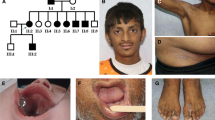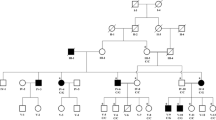Summary
Epidermolytic palmoplantar keratoderma (EPPK) (Vörner-Unna-Thost) is an autosomal dominantly inherited skin disease of unknown etiology characterized by diffuse severe hyperkeratosis of the palms and soles and, histologically, by cellular degeneration. We have mapped a gene for EPPK to chromosome 17q11–q23, with linkage analysis using microsatellite DNA-polymorphisms, in a single large family of 7 generations. A maximum lod score of z=6.66 was obtained with the probe D17S579 at a recombination fraction of θ=0.00. This locus maps to the same region as the type I (acidic) keratin gene cluster. Keratins, members of the intermediate filament family, the major proteins of the cytoskeleton in epidermis, are differentially expressed in a tissue-specific manner. One acidic keratin, keratin 9 (KRT9), is expressed only in the terminally differentiated epidermis of palms and soles. The KRT9 gene has not yet been cloned; however, since the genes for most acidic keratins are clustered, it is highly probable that it too will map to this region. We therefore propose KRT9 as the candidate gene for EPPK.
Similar content being viewed by others
References
Blanchet-Bardon C, Nazzaro V, Chevrant-Breton J, Espie M, Kerbrat P, Le-Marec B (1987) Hereditary epidermolytic palmoplantar keratoderma associated with breast and ovarian cancer in a large kindred. Br J Dermatol 117:363–370
Bonifas JM, Rothman AL, Epstein EH (1991) Epidermolysis bullosa simplex: evidence in two families for keratin gene abnormalities. Science 254:1202–1205
Cooper DN, Smith BA, Cooke HJ, Niemann S, Schmidtke J (1985) An estimate of unique DNA sequence heterozygosity in the human genome. Hum Genet 69:201–205
Coulombe PA, Hutton ME, Letai A, Hebert A, Paller AS, Fuchs E (1991) Point mutations in human keratin 14 genes of epidermolysis bullosa simplex patients: genetic and functional analyses. Cell 66:1301–1311
DerKaloustian VM, Kurban AK (1979) Genetic diseases of the skin. Springer, Berlin Heidelberg New York
Fuchs E, Green H (1980) Changes in keratin gene expression during terminal differentiation of the keratinocyte. Cell 19:1033–1042
Hall JM, Lee MK, Newman B, Morrow JE, Anderson LA, Huey B, King MC (1990) Linkage of early-onset familial breast cancer to chromosome 17q21. Science 250:1684–1689
Hall JM, Friedman L, Guenther C, Lee MK, Weber JL, Black DM, King MC (1992) Closing in on a breast cancer gene on chromosome 17q. Am J Hum Genet 50:1235–1242
Hamada H, Petrino MG, Kakunaga T (1982) A novel repeated element with Z-DNA forming potential is widely found in evolutionary diverse eukaryotic genomes. Proc Natl Acad Sci USA 79:6465–6469
Hentati A, Lamy C, Melki J, Zuber M, Munnich A, Reconde J de (1992) Clinical and genetic hererogeneity of Charcot-Marie-Tooth disease. Genomics 12:155–157
Knapp AC, Franke WW, Heid H, Hatzfeld M, Jorcano JL, Moll R (1986) Cytokeratin no. 9, an epidermal type I keratin characteristic of a special program of keratinocyte differentiation displaying body site specificy. J Cell Biol 103:657–667
Küster W, Becker A (1992) Indication for the identity of palmoplantar keratoderma type Unna-Thost with type Vörner. Thost's family revisited 110 years later. Acta Dermatol Venereol (Stockh) (in press)
Lessin SR, Huebner K, Isobe M, Croce C, Steinert PM (1988) Chromosomal mapping of human keratin genes: evidence for nonlinkage. J Invest Dermatol 91:572–578
Litt M, Luty JA (1989) A hypervariable microsatellite revealed by in-vitro amplification of a dinucleotide repeat within the cardiac muscle actin gene. Am J Hum Genet 434:387–401
McKusick A (1990) Mendelian inheritance in man. 9th (edn). Johns Hopkins University Press, Baltimore
Moll R, Franke WW, Schiller DL, Geiger B, Krepler R (1982) The catalog of human cytokeratins: pattern of expression in normal epithelia, tumors and cultured cells. Cell 31:11–24
Moll I, Heid H, Franke WW, Moll R (1987) Distribution of a special subset of keratinocytes characterized by the expression of cytokeratin 9 in adult and fetal human epidermis of various body sites. Differentiation 33:254–265
Nelson WG, Sun TT (1983) The 50- and 58-kilodalton keratin classes as molecular markers for stratified squamous epithelia: cell culture studies. J Cell Biol 97:244–251
Nordheim A, Rich A (1983) The sequence (dC-dA)n · (dG-dT)n forms left-handed Z-DNA in negatively supercoiled plasmids. Proc Natl Acad Sci USA 80:1821–1825
Ott J (1976) A computer program for linkage analysis in human pedigrees. Am J Hum Genet 28:528–529
Polymeropoulos MH, Rath DS, Xiao H, Merril CR (1990) A simple sequence repeat polymorphism at the human growth hormone locus. Nucleic Acids Res 19:689
Rabbiosi G, Borroni B, Pinelli P, Cosi V (1980) Palmoplantar keratoderma and Charcot-Marie-Tooth disease. Arch Dermatol 116:789–790
Reis A (1991) PCR in linkage analysis of genetic diseases. In: Rolfs A, Schumacher H, Marx P (eds) PCR topics. Usage of polymerase chain reaction in genetic and infectious diseases. Springer, Berlin Heidelberg New York
Romano V, Bosco P, Costa G, Leube R, Franke WW, Rocchi RM, Romeo G (1988) Chromosomal assignment of cytokeratin genes. Cytogenet Cell Genet 46:683
Rosenberg M, RayChaudhury A, Shows TB, Le Beau MM, Fuchs E (1988) A group of type 1 keratin genes on human chromosome 17: characterization and expression. Mol Cell Biol 8:722–736
Rosenberg M, Fuchs E, Le Beau MM, Eddy RL, Shows TB (1991) Three epidermal and one simple epithelial type II keratin genes map to human chromosome 12. Cytogenet Cell Genet 57:33–38
Saiki RK, Gelfand DH, Stoffel S, Scharf SJ, Higuchi R, Horn GT, Mullis KB, Ehrlich HA (1988) Primer-directed enzymatic amplification of DNA with a thermostable DNA polymerase. Science 239:487–491
Stoler A, Kopan R, Duvic M, Fuchs E (1988) Use of monospecific antisera and cRNA probes to localize the major changes in keratin expression during normal and abnormal epidermal differentiation. J Cell Biol 107:427–446
Tautz D (1989) Hypervariability of simple sequences as a general source for polymorphic DNA markers. Nucleic Acids Res 17:6463–6471
Tautz D, Renz M (1984) Simple sequences are ubiquitously repetitive components of eukarvotic genomes. Nucleic Acids Res 12:4127–4138
Thost A (1880) Ueber erbliche Ichthyosis palmaris et plantaris cornea. Diss. Heidelberg
Unna PG (1883) Ueber das Keratoma palmare et plantarc hereditarium. Arch Dermatol Syph (Berlin) 15:231–270
Vörner H (1901) Zur Kenntnis des Keratoma hereditarium palmare et plantare. Arch Dermatol Syph (Berlin) 56:3–31
Weber JL, May PE (1989) Abundant class of human DNA polymorphisms which can be typed using the polymerase chain reaction. Am J Hum Genet 44:388–396
Weber JL, Kwitek AE, May PE, Wallace MR, Collins FS, Ledbetter DH (1990) Dinucleotide repeat polymorphisms at the D17S250 and D17S261 loci. Nucleic Acids Res 18:4640
Weiss RA, Eichner R, Sun TT (1984) Monoclonal antibody analysis of keratin expression in epidermal diseases: a 48- and 56- kdalton keratin as markers for hyperproliferative keratinocytes. J Cell Biol 98:1397–1406
Zuliani G, Hobbs HH (1990) A high frequency of length polymorphisms in repeated sequences adjacent to Alu sequences. Am J Hum Genet 46:963–969
Author information
Authors and Affiliations
Rights and permissions
About this article
Cite this article
Reis, A., Küster, W., Eckardt, R. et al. Mapping of a gene for epidermolytic palmoplantar keratoderma to the region of the acidic keratin gene cluster at 17q12–q21. Hum Genet 90, 113–116 (1992). https://doi.org/10.1007/BF00210752
Received:
Issue Date:
DOI: https://doi.org/10.1007/BF00210752




